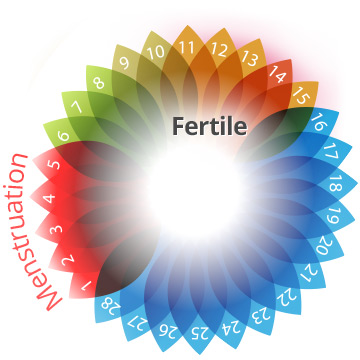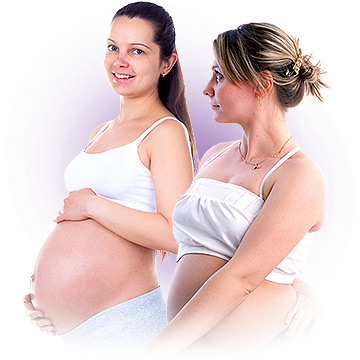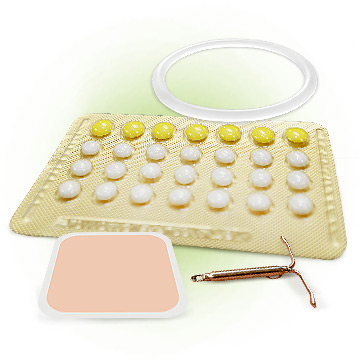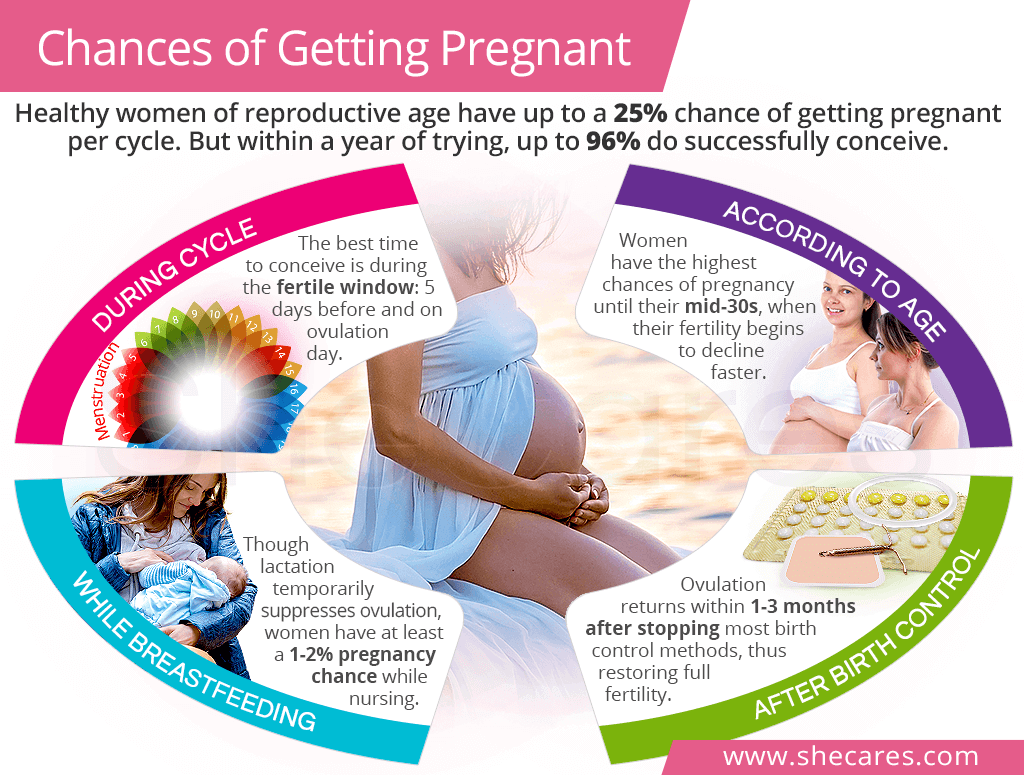Chances of Getting Pregnant in a Cycle

Due to natural hormonal fluctuations driving menstruation, a woman's odds of getting pregnant greatly vary during the cycle. The following breakdown is based on a 28-day cycle, though healthy period patterns can last from 21 to 35 days.
Chances of Pregnancy During Period
For most women with 28-day cycles, the odds of pregnancy while on a period are nil because their fertile window does not start until Day 9. However, those with shorter cycles might be entering their fertility days while still bleeding.
Chances of Pregnancy After Period and Before Ovulation
The odds of pregnancy increase with every day that passes after a period as a woman is approaching her fertile window. Having sex during the five days before ovulation is a woman's best chance to get pregnant. Those with short cycles might already be in their most fertile days right after a period and before ovulation.
Chances of Pregnancy during Ovulation
Ovulation, which lasts for 12 to 24 hours, is the only time during which the egg can be fertilized if the sperm is present by the fallopian tubes. As such, having sex on ovulation day guarantees very high chances of pregnancy.
Chances of Pregnancy After Ovulation and Before Period
The time of the lowest probability of pregnancy is after ovulation and until the next period. When the egg is not fertilized by the sperm during the 24-hour window, it will move to the uterus to be shed about two weeks later with menstrual bleeding.
Additional Information
For women with irregular periods or irregular ovulation, it is best to track their menstrual patterns with the help of ovulation tests, such as checking cervical mucus, as they help detect bodily clues that fertile days are approaching.
Keep on reading to learn more about the chances of getting pregnant each month or continue to the next section to discover how age affects your odds of conceiving.
Chances of Getting Pregnant by Age

Women are generally conscious of an age-related natural fertility decline. Many, however, are not sure what exactly their odds of pregnancy are at various ages.
Chances of Pregnancy in the 20s
A woman in her 20s has the best chance to get pregnant, about 25% per cycle, as her ovarian reserve is abundant, and the majority of her eggs are chromosomally normal. As such, 96% of 20-year-olds conceive within a year of trying.
Chances of Pregnancy in the 30s
Turning 30 comes with the first reproductive challenges, although a woman's fertility rates continue high with about 86% of women in this age range conceiving within a year. However, fertility at 35 begins to declines at faster rates.
Chances of Pregnancy in the 40s
Chances of Pregnancy in the 50s
Getting pregnant naturally after 50 is impossible for most women as they reach menopause in their early 50s, ending their reproductive abilities. After menopause, women can get pregnant only using in vitro fertilization (IVF) with younger donor eggs.Continue reading for more information about the chances of getting pregnant by age or keep reading below to learn about the probability of pregnancy on birth control.
Chances of Getting Pregnant on Birth Control

A woman's odds of pregnancy mainly depend on two factors: the type of birth control she is on and her diligence in following the schedule.
Failure rates of various contraceptive methods are often based on perfect use, which means a woman is using them as instructed every single time she has sex. In reality, most women practice what is referred to as typical use, which includes human error, such as forgetting the pill.
Most Effective
require no diligenceVery Effective
but require high diligenceLeast Effective
due to high risk of human errorContinue reading more about the likelihood of pregnancy on birth control or check the section below to learn about the chances of pregnancy after stopping birth control.
Chances of Getting Pregnant after Birth Control

Despite common belief, women have the same chances of pregnancy after getting off birth control as those who have not used it.
However, what is more important is how quickly a woman's fertility returns after stopping birth control. For pregnancy to occur, a woman has to be ovulating. Because most birth control methods work by preventing ovulation, it might take time for normal ovulatory cycles to be fully restored.
NO DELAY
SHORT DELAY
LONG DELAY
It is important to remember that how long it takes to conceive depends on other factors as well. Consequently, it can take up to a year for a healthy couple to conceive.
Keep on reading on find out more about chances of pregnancy after getting off birth control or move on to the next section to read about the odds of conception while nursing.
Chances of Getting Pregnant while Breastfeeding

How Does Breastfeeding Prevent Pregnancy?
Milk production in the breast is stimulated by the hormone prolactin following childbirth. Prolactin inhibits the release of other hormones that normally signal the ovaries to mature the eggs in the preparation for ovulation. Without those hormones, the ovulatory cycle cannot kick off. If a woman is not ovulating, conception cannot occur.
How Likely is it to Get Pregnant while Breastfeeding?
Generally, it is unlikely for a woman who is breastfeeding and whose period has not returned yet to get pregnant. In some cases, however, a woman might ovulate before the arrival of the first post-partum menses.
The likelihood of conceiving while breastfeeding is most commonly determined by the frequency and total amount of time the baby spends at the breasts per 24 hours. The two types of breastfeeding that are commonly used to delay the return of full fertility, exclusive and ecological breastfeeding, can range in their effectiveness varies from 1 to 6%.
Key Takeaways
As couples give conceiving a try, they often anxiously weigh their probability of pregnancy if they do not succeed right away, automatically suspecting infertility problems. In reality, making a baby is not as simple as it may seem, and it may take a healthy couple up to year of active trying to get pregnant.
For starters, learning to time intercourse with a woman's most fertile days takes several months of diligent tracking of menstrual patterns. Although progressing age does not affect men to a great extent, women's fertility is time-limited and rapidly declines after 35 as the ovaries run out of eggs, thus reducing the chances of pregnancy. When time is of the essence, possible fertility delays after stopping birth control might further complicate conception trials. Understanding all of the factors that naturally determine how likely is it to get pregnant is key to optimizing the baby-making process for ultimate success.
Sources
- American College of Obstetricians and Gynecologists. (2018). Barrier Methods of Birth Control. Retrieved February 20, 2019 from https://www.acog.org/~/media/For%20Patients/faq022.pdf?dmc=1&ts=20120604T2122545757
- American Pregnancy Association. (2018). Breastfeeding While Pregnant. Retrieved February 20, 2019 from http://americanpregnancy.org/breastfeeding/breastfeeding-while-pregnant/
- American Pregnancy Association. (2016). Pregnancy after Tubal Ligation – Is It Possible? Retrieved February 20, 2019 from http://americanpregnancy.org/preventing-pregnancy/pregnancy-tubal-ligation/
- Berkeley University. (2011). Your Guide to Breastfeeding. Retrieved February 20, 2019 from https://uhs.berkeley.edu/sites/default/files/wellness-womenshealth_breastfeedingguide_0.pdf
- Breastfeeding USA. (n.d.). Understanding Your Fertility while Breastfeeding. Retrieved February 20, 2019 from https://breastfeedingusa.org/content/article/understanding-your-fertility-while-breastfeeding
- Eunice Kennedy Shriver National Institute of Child Health and Human Development. (2017). What are the different types of contraception? Retrieved February 20, 2019 from https://www.nichd.nih.gov/health/topics/contraception/conditioninfo/types
- Food and Drug Administration. (2018). Birth Control. Retrieved February 20, 2019 from https://www.fda.gov/forconsumers/byaudience/forwomen/freepublications/ucm313215.htm
- International Journal of Applied & Basic Medical Research. (2014). Female sterilization failure: Review over a decade and its clinicopathological correlation. Retrieved February 20, 2019 from https://www.ncbi.nlm.nih.gov/pmc/articles/PMC4137647/
- John Hopkins Medicine. (n.d.). Tubal Ligation. Retrieved February 20, 2019 from https://www.hopkinsmedicine.org/healthlibrary/test_procedures/gynecology/tubal_ligation_135,27
- Mayo Clinic. (2018). Tubal Ligation. Retrieved February 20, 2019 from https://www.mayoclinic.org/tests-procedures/tubal-ligation/about/pac-20388360
- May Clinic. (2018). Tubal Ligation Reversal. Retrieved February 20, 2019 from https://www.mayoclinic.org/tests-procedures/tubal-ligation-reversal/about/pac-20395158
- Natural Family Planning International. (2011). Ecological Breastfeeding and Exclusive Breastfeeding. Retrieved February 20, 2019 from http://nfpandmore.org/wordpress/?p=1571
- Planned Parenthood. (n.d.). What is the effectiveness of a Tubal Ligation Procedure? Retrieved February 20, 2019 from https://www.plannedparenthood.org/learn/birth-control/sterilization/how-effective-tubal-ligation
- Stanford Medicine. (n.d.). Getting Started with Breastfeeding. Retrieved February 20, 2019 from https://med.stanford.edu/newborns/professional-education/breastfeeding.html
- Washington University of St. Louis. (2015). IUD, implant contraception effective beyond FDA-approved use. Retrieved February 20, 2019 from https://source.wustl.edu/2015/02/iud-implant-contraception-effective-beyond-fdaapproved-use/


